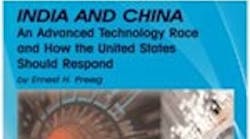Editor's Note: This commentary is based on the book," India & China: An Advanced Technology Race & How the U.S. Should Respond," by Enerest H. Preeg
A rapid, technology-driven transformation is taking place within the global economy. India and China are playing decisive roles in this transformation as emerging advanced technology superstates. China is five to ten years ahead of India in most respects, but India is ahead in a few areas and is closing the gap in others. Chinese exports are far larger for manufactures, while India has the lead for business services. There is growing competition for foreign direct investment featuring large R&D components. Indian multinational companies, especially when including outward foreign direct investment, are ahead of Chinese companies not only for business services, but in the pharmaceutical, automotive and steel sectors as well.
The likely courses over the coming two to five years is that it is highly likely that India will continue its 8% to 10% annual growth, while China is equally likely to experience a "hard landing" adjustment from excessively export-oriented to more domestically-oriented growth, including slower growth for at least a couple of years.
Both nations face obstacles to continued high growth, but India is on a more balanced growth path, with growing momentum from private sector investment, including for urgently needed infrastructure. China has had higher, 10% to 11% growth, but half or more of the growth has been accounted for by increased exports of manufactures and related investment. External and internal pressures to shift toward more domestically-oriented growth, including through a major revaluation of the yuan, are building, but the restructuring faces formidable obstacles.
The United States needs a forceful and comprehensive policy response to this rapid rise of China and India to advanced technology superstate status. In the short to medium term, economic policy issues will dominate, while over the longer term foreign policy and national security issues will become more important.
The current economic policy context for the United States features a somewhat contradictory combination of very large and growing mutual gains from open trade and an international policy framework which has shifted out of balance to the detriment of U.S. technology leaders and the manufacturing and business services sectors more broadly. The policy response therefore needs to continue to encourage the mutual gains from free trade while righting the balance in the policy framework so that trade and investment flows are determined by competitive market forces rather than government manipulation.
For trade policy, the mutual benefits of free trade should be pursued through further U.S. bilateral free trade agreements, especially across the Pacific so as to avoid an Asian preferential trade arrangement excluding the United States. Congressional approval of the U.S.-Korean FTA is critical for this path. The longer term objective should be to consolidate the many bilateral FTAs into a multilateral free trade agreement, at least for nonagricultural trade.
A supportive domestic economic policy agenda is also essential. In recent years, trading partners, especially China and India, have increased incentives to make their economies more investment friendly, while the United States, in a number of areas, has been moving in an investment unfriendly direction. Specific policy areas in need of change to strengthen U.S. export competitiveness and technological innovation include education, public support for basic R&D, energy, corporate taxation, and tort reform.
Longer term, the technology-driven transformation of the global economy is leading to fundamental change in the world economic and political orders. The new world order will center increasingly on the three existing or soon to be advanced technology superstates --the United States, China, and India --together with the European Union, an advanced technology superpower although not a state with a unified military and foreign policy. These four advanced technology superpowers, moreover, are also the economic hegemons --the dominant economic powers --within the advanced technology regions of North America, West Europe, East Asian, and South Asia.
These momentous developments are leading to a new order of international relations. In terms of nation states, the new Asia-Pacific Triangle of the United States, China, and India will increasingly play a decisive role in the course of international events. And in this context there would be a very different world order of nations if all three were democracies, based on the rule of law and individual freedom, rather than facing the current political divide between the two largest democracies and the largest authoritarian state.
Ernest H. Preeg is a Senior Fellow in Trade and Productivity at Manufacturers Alliance/MAPI. To order Dr. Preeg's book, please visit www.mapi.net




